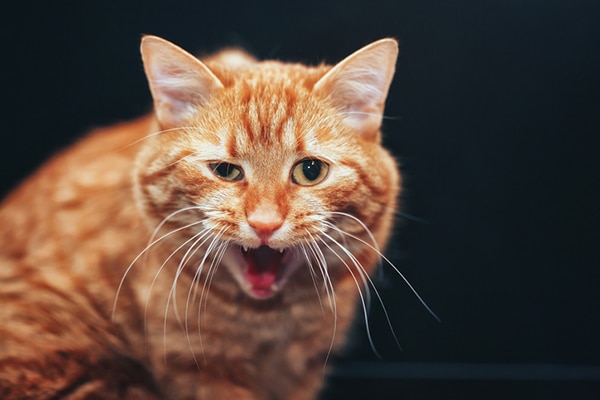Caterwauling — What Is It and Why Do Cats Do It?
The post Caterwauling — What Is It and Why Do Cats Do It? by Angie Bailey appeared first on Catster. Copying over entire articles infringes on copyright laws. You may not be aware of it, but all of these articles were assigned, contracted and paid for, so they aren't considered public domain. However, we appreciate that you like the article and would love it if you continued sharing just the first paragraph of an article, then linking out to the rest of the piece on Catster.com.
We’re all pretty familiar with our cats’ everyday meows and other cat sounds, but when the pitch gets higher, drawn-out, melodic and “yowly,” it’s time to really pay attention. This type of sound is called caterwauling, and there’s nearly always a reason behind caterwauling — we humans just have to pause for further examination. Here are some reasons why you might hear caterwauling, and what you can do to help remedy the situation.
1. Cats caterwaul because they’re in pain

What does caterwauling mean? Photography by Valery Kudryavtsev/Thinkstock.
Cats are known for hiding their pain, so if your cat starts caterwauling, and there’s not an immediate reason why this would be happening, start with a veterinary visit to rule out anything health related. In addition to several medical causes that could result in caterwauling, cats of all ages can develop overactive thyroid and kidney disease, both of which can result in excessive vocalizations, including caterwauling.
2. Caterwauling might signal the need to breed
Cats who are not spayed or neutered can produce plenty of noise. Female cats in heat caterwaul to attract a male, and males who aren’t neutered caterwaul when they know a female is in heat. The best way to remedy this situation as well as help control cat overpopulation: Spay and neuter your cats.
3. Cats caterwaul to alert us to outside activity
Most of us have heard our cats making caterwauling sounds and rushed to see what’s up, only to find kitty looking out a window with great concern. Upon further investigation, we’ll typically see another cat who’s planted him or herself on our cat’s “turf,” which doesn’t sit well with the territorial feline master or mistress of the house. Remove the source of the agitation by closing windows and blinds to restrict your cat’s view of the “intruder.”
4. Cats might caterwaul when they are feeling insecure or vulnerable
Cats are known to yowl when they’re feeling psychological stress like insecurity or vulnerability. Some cats are naturally clingy and feel anxious when their human leaves the house — or even the room. They feel abandoned and then the caterwauling begins.
This can be especially true when the family changes residences. The cat is no longer familiar with his surroundings, so he feels even more stressed when he can’t find the comfort of his human.
If you know your cat is subject to these kinds of behaviors, it’s important to anticipate his needs and reactions and reassure him of his safety. Bring him to bed with you at night so he sees that you haven’t left him alone. Give him extra cuddles, especially when there are possible triggers like company coming over or a change in housing.
5. Cats caterwaul to get your attention
Some cats resort to caterwauling when they want or need something from us. It could be food, water, physical attention, play or any number of reasons. While it’s important to make sure our cats’ basic needs are met, they’ve been known to use caterwauling as a manipulation tool. If you get up to give your cat treats when he starts caterwauling in the middle of the night, he’ll soon learn that caterwauling = treats. Of course, it’s critical to have him examined by a vet to rule out any serious reasons for the caterwauling; however, sometimes cats are like human toddlers, and they know how to train us.
6. Caterwauling might mean you cat is disoriented
As cats age, we sometimes see changes in their cognitive functioning. According to the ASPCA, feline cognitive dysfunction (FCD or cat dementia) affects more than 55 percent of cats aged 11 to 15 years old and more than 80 percent of cats aged 16 to 20. Excessive vocalization and caterwauling can be just one symptom of FCD, but it’s important to familiarize yourself with all the symptoms, especially if you share your life with a senior cat. Here’s the ASPCA’s cognitive dysfunction checklist.
Don’t ignore caterwauling
If your cat begins caterwauling, don’t assume it’s typical cat behavior. Stop and look for reasons why it’s happening, and take the appropriate actions. As always, check with a veterinary professional to rule out anything serious, or if you have any concerns at all about your cat’s health or behavior.
Tell us: Does your cat caterwaul?
Thumbnail: Photography ©s_derevianko | iStock / Getty Images Plus.
This piece was originally published in 2018.
Read more about cat sounds on Catster.com:
- Why Do Cats Purr? Cat Purrs Don’t Always Mean Your Kitty is Happy
- Let’s Talk Cat Growling — Why Does Your Cat Growl and How Should You React?
- Cat Trilling: Why It Happens and What Your Cat Is Telling You
The post Caterwauling — What Is It and Why Do Cats Do It? by Angie Bailey appeared first on Catster. Copying over entire articles infringes on copyright laws. You may not be aware of it, but all of these articles were assigned, contracted and paid for, so they aren't considered public domain. However, we appreciate that you like the article and would love it if you continued sharing just the first paragraph of an article, then linking out to the rest of the piece on Catster.com.




Post a Comment